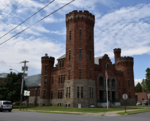Oswegatchie River
AdirondacksCanoeing and kayaking venues in the United StatesFishing areasRivers of Hamilton County, New YorkRivers of Lewis County, New York ... and 3 more
Rivers of New York (state)Rivers of St. Lawrence County, New YorkTributaries of the Saint Lawrence River

The Oswegatchie River is a 137-mile-long (220 km) river in northern New York that flows from the Adirondack Mountains north to the Saint Lawrence River. The Oswegatchie River begins at Partlow Lake in Hamilton County, New York. The river continues through Cranberry Lake which was 'doubled in size' through construction of a dam in the late 1860s. The river continues from the dam to Gouverneur, to near Talcville in St. Lawrence County, where it joins the West Branch. Much of it is within Adirondack State Park. The city of Ogdensburg developed at the mouth of the river at its confluence with the St. Lawrence.
Excerpt from the Wikipedia article Oswegatchie River (License: CC BY-SA 3.0, Authors, Images).Oswegatchie River
Downtown Arterial Highway, City of Ogdensburg
Geographical coordinates (GPS) Address Nearby Places Show on map
Geographical coordinates (GPS)
| Latitude | Longitude |
|---|---|
| N 44.6958958 ° | E -75.4974483 ° |
Address
Downtown Arterial Highway
Downtown Arterial Highway
13669 City of Ogdensburg
New York, United States
Open on Google Maps






